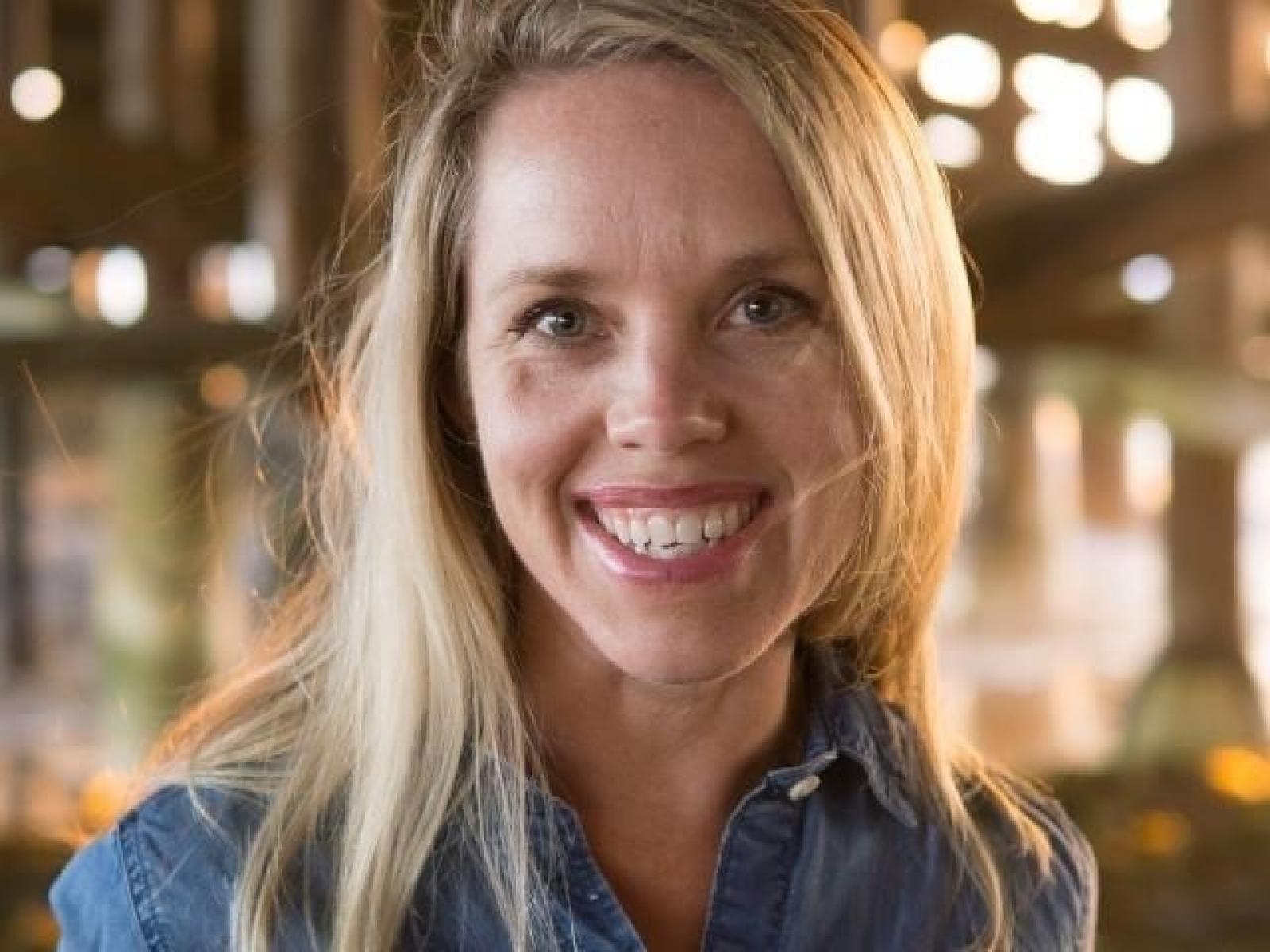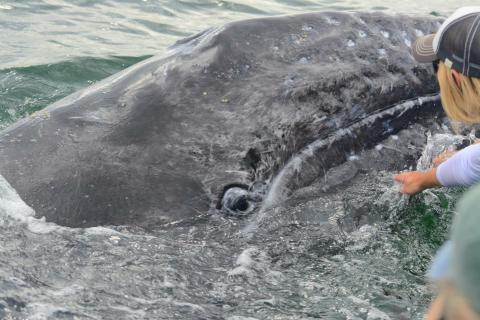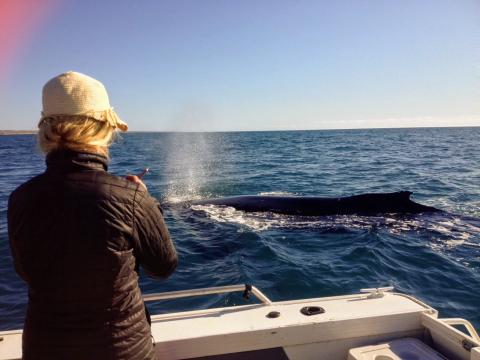Bringing Triton’s Vision to Life: Project Management with Alicia Amerson

Scientists and engineers at Pacific Northwest National Laboratory strive to decrease our reliance on fossil fuels by researching ways to implement wave and tidal energy into the U.S. energy portfolio.
According to the United States Energy Information Administration, the projected wave energy potential off the U.S. coasts is estimated to be ~2.64 trillion kilowatt-hours, or 64 percent of our nation’s electricity generation in 2019. The ocean’s waves and tides are some of the most consistent natural phenomena on Earth. Due to gravitational forces of the sun and moon, we can count on tides rising and falling twice a day, occurring with such regularity that they can be predicted decades in advance. Additionally, tides have extremely high energy density compared to other energy resources, which means little energy is wasted in the process of converting tides’ power into electricity. Similarly, the CalWave Wave Energy Test Site in La Jolla, California, claims ocean waves are 20-60 times more energy-dense, predictable, and consistent compared to other forms of renewable energy. Collectively, wave and tidal energy are referred to as marine energy.
The U.S. has faced many challenges to implement marine energy devices into ocean ecosystems. Currently, a substantial challenge is due to the uncertainty around the environmental impacts of these devices. In order to permit the installation of marine energy devices into coastal areas or in deeper oceanic waters, federal and state regulators need to be confident that energy-producing technologies, such as tidal turbines and wave energy converters, are monitored to reduce, or do no, harm to marine habitats and marine wildlife.
The Triton Initiative is a U.S. Department of Energy (DOE) Water Power Technologies Office project with the mission to remove barriers to testing and permitting marine energy by improving environmental monitoring around marine energy installations. The Triton Initiative comprises projects designed to develop and test environmental monitoring technologies and methods to better understand marine energy’s potential effects on habitats and marine wildlife. These findings will be provided to regulators to make informed decisions. Triton’s two projects include the Triton Field Trials and support for other DOE-funded projects developing innovative monitoring technologies. A newer task in the project is creating a template for how Triton conducts communication, outreach, and engagement alongside the brilliant PNNL communications team. The project manager leading these many efforts is marine biologist and conservation photography storyteller, Alicia Amerson.
Through building a strategic vision and communicating effectively, a team can work toward a common goal successfully. This is what Amerson strives to do for Triton. “As a project manager, I am tasked to provide the team with resources to get the job done, while also sharing the outcomes of the work in a positive way, connecting the team and our work to global communities and our country,” says Amerson.
Becoming a project manager
Amerson’s path to Triton was winding and full of diverse experiences. She started her career monitoring the watersheds at Los Alamos National Laboratory (LANL) after earning her BS in biology from Eastern New Mexico University in 2002. Her work at LANL focused on compliance with federal stormwater pollution prevention permits and managing waste generated from the environmental remediation of the Manhattan Project Site. For Amerson, this was a valuable learning experience, not only for teaching her about radiological and hazardous waste, but also about communication within teams, working safely in the field, and the importance of our national policies in place to protect the air, land, and water. She found her work at LANL rewarding, but for her, the one thing missing in New Mexico was the ocean.

Amerson's desire to learn more about ways to remediate ocean pollution led her to San Diego, where she worked for San Diego Gas and Electric as a project manager. After a short time living in California, Amerson decided to pursue a MS degree at the Center for Marine Conservation and Biodiversity program at Scripps Institution of Oceanography. Her research took her from San Ignacio Lagoon on the Pacific Coast of Baja de California, north along the entire West Coast of the U.S., and up to Tofino, British Columbia, Canada, to observe whale watching boat operations. She hopped aboard whale watching vessels to learn how they apply regulations and guidelines to conduct sustainable operations. Canada and the U.S. have guidelines, while Mexico has stringent restrictions in place designed to ensure the wellbeing of whales is not negatively impacted by tourism activities. She learned that the connection between the human desire to see animals (tourism impacts) and their ability to adapt to our population growth (loss of wildlife habitat) is an important consideration as the human footprint increases. Protecting habitat is essential to preventing local extinction and ensuring success for wildlife in the face of climate change. This is a challenge we can all address at a local level in our changing world, and an issue Amerson is deeply passionate about.
After completing her MS, she participated in a research project measuring bioenergetics of humpback whale mothers and calves in Exmouth, Western Australia, with the Murdoch University Cetacean Research Unit. She returned for a second field season to fly drones over whales off the Head of the Bight in South Australia, which led her to an interest in the growing popularity of hobby drone activity and negative wildlife responses being displayed on social media. The creation of drone flight guidelines to prevent wildlife harassment took her all over the world to speak about this issue. Between field seasons, she worked for Lieutenant Governor Gavin Newsom as a California Sea Grant Fellow, helping to build his ocean initiatives. During this fellowship, she took on a project to work with policy makers to secure state funding for volunteer organizations, like The Marine Mammal Center, that were responding to the increased pinniped stranding and whale entanglements along the California coast at that time. From these many experiences, she learned the common thread throughout her career is a love for project management. Early in 2020, she joined the Marine and Coastal Research Laboratory at the Pacific Northwest National Laboratory as the project manager for Triton.
Leading the Triton Initiative to success
Project management is a critical piece of the Triton Initiative because it is the link between research teams and sponsors. Amerson’s leadership helps the team align with the mission requirements, organize resources, track schedule, and budget, and ensure deliverables are high quality. Amerson draws from her scientific background and organizational skills to keep the team motivated, inspired, and working toward Triton’s project milestones. One of the most impactful things Amerson does is get to know her team well and learn what motivates them. This helps her integrate her team's passions and goals into Triton’s research and provides them opportunities to step into new roles and grow as researchers.
“When my project team exceeds requirements and does well, it creates wins for our DOE sponsor who can relay to taxpayers how we are progressing marine energy for the benefit of our country,” says Amerson. "The more marine energy devices are deployed and tested, the faster we can reduce our dependency on fossil fuels.” Amerson also understands the increasing importance of science communications in achieving this goal; this sets the groundwork for large communication, outreach, and engagement efforts for Triton this year. She has a vision and knows how to implement it.
“I love communicating and presenting the Triton program to external stakeholders,” says Amerson. Her dedication to open conversation and understanding the perspectives of diverse stakeholders has served Triton because it ensures everyone at the marine energy table feels heard. If scientists and engineers are siloed and conducting research that doesn’t help answer the questions regulators need to permit marine energy projects, the work is not being done effectively. Amerson’s holistic view of the Triton program cultivates collaboration, trust, and ingenuity so Triton can best serve the industry.
One of Amerson’s favorite aspects of her job is how she is able to dabble in various research topics associated with environmental monitoring for marine energy. She feels lucky to learn from the brilliant scientists and engineers she works with every day. “Their commitment to understanding the challenges associated with deploying marine energy devices keeps me motivated and hopeful that we will succeed in meeting the climate goals set by our new administration,” notes Amerson. The members of the Triton Initiative are a true team.
Amerson looks forward to helping build the future of Triton and develop creative solutions to the marine energy industry’s greatest needs. As a scientist, she is fascinated by the physiological and behavioral responses of animals to human change and hopes Triton can continue to play a role in providing environmental monitoring information to progress marine energy installation. The opportunities are endless. “It’s an honor to work on this project because of the mission to understand environments where devices may be placed,” says Amerson. She adds, “I feel grateful to have the opportunity to lead a project that generates clean renewable energy, adds value for all Americans, and has the potential to provide scientific value for the rest of the world.”

Written by Cailene Gunn.
Subscribe to our monthly newsletter here.
Published: February 2, 2021